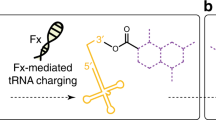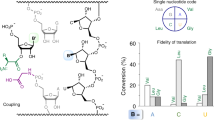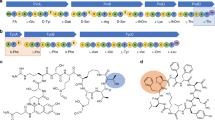Abstract
An unnatural base pair of 2-amino-6-(2-thienyl)purine (denoted by s) and pyridin-2-one (denoted by y) was developed to expand the genetic code. The ribonucleoside triphosphate of y was site-specifically incorporated into RNA, opposite s in a template, by T7 RNA polymerase. This transcription was coupled with translation in an Escherichia coli cell-free system. The yAG codon in the transcribed ras mRNA was recognized by the CUs anticodon of a yeast tyrosine transfer RNA (tRNA) variant, which had been enzymatically aminoacylated with an unnatural amino acid, 3-chlorotyrosine. Site-specific incorporation of 3-chlorotyrosine into the Ras protein was demonstrated by liquid chromatography–mass spectrometry (LC-MS) analysis of the products. This coupled transcription–translation system will permit the efficient synthesis of proteins with a tyrosine analog at the desired position.
This is a preview of subscription content, access via your institution
Access options
Subscribe to this journal
Receive 12 print issues and online access
$209.00 per year
only $17.42 per issue
Buy this article
- Purchase on Springer Link
- Instant access to full article PDF
Prices may be subject to local taxes which are calculated during checkout





Similar content being viewed by others
References
Noren, C.J., Anthony-Cahill, S.J., Griffith, M.C. & Schultz, P.G. A general method for site-specific incorporation of unnatural amino acids into proteins. Science 244, 182–188 (1989).
Hecht, S.M. Probing the synthetic capabilities of a center of biochemical catalysis. Acc. Chem. Res. 25, 545–5552 (1992).
Saks, M.E. et al. An engineered Tetrahymena tRNAGln for in vivo incorporation of unnatural amino acids into proteins by nonsense suppression. J. Biol. Chem. 271, 23169–23175 (1996).
Nowak, M.W. et al. In vivo incorporation of unnatural amino acids into ion channels in Xenopus oocyte expression system. Methods Enzymol. 293, 504–529 (1998).
Service, R.F. Creation's seventh day. Science 289, 232–235 (2000).
van Hest, J.C.M., Kiick, K.L. & Tirrell, D.A. Efficient incorporation of unsaturated methionine analogs into proteins in vivo. J. Am. Chem. Soc. 122, 1282–1288 (2000).
Böck, A. Invading the genetic code. Science 292, 453–454 (2001).
Kowal, A.K., Köhrer, C. & RajBhandary, U.L. Twenty-first aminoacyl-tRNA synthetase-suppressor tRNA pairs for possible use in site-specific incorporation of amino acid analogs into proteins in eukaryotes and in eubacteria. Proc. Natl. Acad. Sci. USA 98, 2268–2273 (2001).
Wang, L., Brock, A., Herberich, B. & Schultz, P.G. Expanding the genetic code of Escherichia coli. Science 292, 498–500 (2001).
Döring, V. et al. Enlarging the amino acid set of Escherichia coli by infiltration of the valine coding pathway. Science 292, 5001–5004 (2001).
Leinfelder, W., Zehelein, E., Mandrand-Berthelot, M. & Böck, A. Gene for a novel tRNA species that accepts l-serine and cotranslationally inserts selenocysteine. Nature 331, 723–725 (1988).
Cload, S.T., Liu, D.R., Forland, W.A. & Schultz, P.G. Development of improved tRNAs for in vitro biosynthesis of proteins containing unnatural amino acids. Chem. Biol. 3, 1033–1038 (1996).
Murakami, H., Hohsaka, T., Ashizuka, Y. & Sisido, M. Site-directed incorporation of p-nitrophenylalanine into streptavidin and site-to-site photoinduced electron transfer from a pyrenyl group to a nitrophenyl group on the protein framework. J. Am. Chem. Soc. 120, 7520–7529 (1998).
Hosaka, T., Kajihara, D., Ashizuka, Y., Murakami, H. & Sisido, M. Efficient incorporation of nonnatural amino acids with large aromatic groups into streptavidin in in vitro protein synthesizing systems. J. Am. Chem. Soc. 121, 34–40 (1999).
Moore, B., Persson, B.C., Nelson, C.C., Gesteland, R.F. & Atkins, J.F. Quadruplet codons: implications for code expansion and the specification of translation step size. J. Mol. Biol. 298, 195–209 (2000).
Magliery, T.J., Anderson, J.C. & Schultz, P.G. Expanding the genetic code: selection of efficient suppressors of four-base codons and identification of “shifty” four-base codons with a library approach in Escherichia coli. J. Mol. Biol. 307, 755–769 (2001).
Bain, J.D., Glabe, C.G., Dix, T.A. & Chamberlin, A.R. Biosynthetic site-specific incorporation of a non-natural amino acid into a polypeptide. J. Am. Chem. Soc. 111, 8013–8014 (1989).
Judice, J.K., Gamble, T.R., Murphy, E.C., de Vos, A.M. & Schultz, P.G. Probing the mechanism of staphylococcal nuclease with unnatural amino acids: kinetic and structural studies. Science 261, 1578–1581 (1993).
Cornish, V.W. et al. Site-specific incorporation of biophysical probes into proteins. Proc. Natl. Acad. Sci. USA 91, 2910–2914 (1994).
Nowak, M.W. et al. Nicotinic receptor binding site probed with unnatural amino acid incorporation in intact cells. Science 268, 439–442 (1995).
Mamaev, S.V., Laikhter, A.L., Arslan, T. & Hecht, S.M. Firefly Luciferase: alteration of the color of emitted light resulting from substitutions at position 286. J. Am. Chem. Soc. 118, 7243–7244 (1996).
Turcatti, G. et al. Probing the structure and function of the tachykinin neurokinin-2 receptor through biosynthetic incorporation of fluorescent amino acids at specific sites. J. Biol. Chem. 271, 19991–19998 (1996).
Yabuki, T. et al. Dual amino acid-selective and site-directed stable-isotope labeling of the human c-Ha-Ras protein by cell-free synthesis. J. Biomol. NMR 11, 295–306 (1998).
Short, G.F. et al. Probing the S1/S1' substrate binding pocket geometry of HIV-1 protease with modified aspartic acid analogues. Biochemistry 39, 8768–8781 (2000).
Short, G.F., Golovine, S.Y. & Hecht, S.M. Effects of release factor 1 on in vitro protein translation and the elaboration of proteins containing unnatural amino acids. Biochemistry 38, 8808–8819 (1999).
Benner, S.A., Burgstaller, P., Battersby, T.R. & Jurczyk, S. Did the RNA world exploit an expanded genetic alphabet? In The RNA world, Edn. 2. (eds Gesteland, R.F., Cech, T. & Atkins, J.F.) 163–181 (Cold Spring Harbor Laboratory Press, Cold Spring Harbor, NY; 1999).
Bain, J.D., Switzer, C., Chamberlin, A.R. & Benner, S.A. Ribosome-mediated incorporation of a non-standard amino acid into a peptide through expansion of the genetic code. Nature 356, 537–539 (1992).
Switzer, C.Y., Moroney, S.E. & Benner, S.A. Enzymatic recognition of the base pair between isocytidine and isoguanosine. Biochemistry 32, 10489–10496 (1993).
Lutz, M.J., Horlacher, J. & Benner, S.A. Recognition of 2'-deoxyisoguanosine triphosphate by HIV-1 reverse transcriptase and mammalian cellular DNA polymerases. Bioorg. Med. Chem. Lett. 8, 499–504 (1998).
Ogawa, A.K. et al. Efforts toward the expansion of the genetic alphabet: information storage and replication with unnatural hydrophobic base pairs. J. Am. Chem. Soc. 122, 3274–3287 (2000).
Wu, Y. et al. Efforts toward expansion of the genetic alphabet: optimization of interbase hydrophobic interactions. J. Am. Chem. Soc. 122, 7621–7632 (2000).
Spirin, A.S., Baranov, V.I., Ryabova, L.A., Ovodov, S.Y. & Alakhov, Y.B. A continuous cell-free translation system capable of producing polypeptides in high yield. Science 242, 1162–1164 (1988).
Kigawa, T. et al. Cell-free production and stable-isotope labeling of milligram quantities of proteins. FEBS Lett. 442, 15–19 (1999).
Madin, K., Sawasaki, T., Ogasawara, T. & Endo, Y. A highly efficient and robust cell-free protein synthesis system prepared from wheat embryos: plants apparently contain a suicide system directed at ribosomes. Proc. Natl. Acad. Sci. USA 97, 559–564 (2000).
Shimizu, Y. et al. Cell-free translation reconstituted with purified components. Nat. Biotechnol. 19, 751–755 (2001).
Ishikawa, M., Hirao, I. & Yokoyama, S. Synthesis of 3-(2-deoxy-β-d-ribofuranosyl)pyridine-2-one and 2-amino-6-(N,N-dimethylamino)-9-(2-deoxy-β-d-ribofuranosyl)purine derivatives for an unnatural base pair. Tetrahedron Lett. 41, 3931–3934 (2000).
Ohtsuki, T. et al. Unnatural base pair for specific transcription. Proc. Natl. Acad. Sci. USA 98, 4922–4925 (2001).
Piccirilli, J.A., Krauch, T., Moroney, S.E. & Benner, S.A. Enzymatic incorporation of a new base pair into DNA and RNA extends the genetic alphabet. Nature 343, 33–37 (1990).
Rappaport, H.P. Replication of the base pair 6-thioguanine/5-methyl-2-pyrimidinone with the large Klenow fragment of Escherichia coli DNA polymerase I. Biochemistry 32, 3047–3057 (1993).
Morales, J.C. & Kool, E.T. Efficient replication between non-hydrogen-bonded nucleoside shape analogues. Nat. Struct. Biol. 5, 950–954 (1998).
Matray, T.J. & Kool, E.T. A specific partner for abasic damage in DNA. Nature 399, 704–708 (1999).
Fujiwara, T., Kimoto, M., Sugiyama, H., Hirao, I. & Yokoyama, S. Synthesis of 6-(2-thienyl)purine nucleoside derivatives that form unnatural base pair with pyridin-2-one nucleosides. Bioorg. Med. Chem. Lett. 11, 2221–2223 (2001).
Kigawa, T., Muto, Y. & Yokoyama, S. Cell-free synthesis and amino acid-selective stable isotope labeling of proteins for NMR analysis. J. Biomol. NMR 6, 129–134 (1995).
Ohyama, T., Nishikawa, K. & Takemura, S. Studies on T. utilis tRNATyr variants with enzymatically altered D loop sequences. I. Deletion of the conserved sequence Gm–G and its effects on aminoacylation and conformation. J. Biochem. 97, 29–36 (1985).
Ohtsuki, T. et al. Preparation of biologically active Ascaris suum mitochondrial tRNAMet with a TV-replacement loop by ligation of chemically synthesized RNA fragments. Nucleic Acids Res. 24, 662–667 (1996).
Chow, C.M. & RajBhandary, U.L. Saccharomyces cerevisiae cytoplasmic tyrosyl-tRNA synthetase gene. Isolation by complementation of a mutant Escherichia coli suppressor tRNA defective in aminoacylation and sequence analysis. J. Biol. Chem. 268, 12855–12863 (1993).
Ohno, S. et al. Co-expression of yeast amber suppressor tRNATyr and tyrosyl-tRNA synthetase on Escherichia coli: possibility to expand the genetic code. J. Biochem. 124, 1065–1068 (1998).
Kern, D., Giegé, R. & Ebel, J.-P. Incorrect aminoacylations catalysed by the phenylalanyl- and valyl-tRNA synthetases from yeast. Eur. J. Biochem. 31, 148–155 (1972).
Ohno, S., Yokogawa, T. & Nishikawa, K. Changing the amino acid specificity of yeast tyrosyl-tRNA synthetase by genetic engineering. J. Biochem. 130, 417–423 (2001).
Hocek, M., Holy, A., Votruba, I. & Dvoráková, H. Cytostatic 6-arylpurine nucleosides III. Synthesis and structure–activity relationship study in cytostatic activity of 6-aryl-, 6-hetaryl- and 6-benzylpurine ribonucleosides. Coolect. Czech. Chem. Commun. 66, 483–499 (2001).
Kawasaki, H., Emori, Y. & Suzuki, K. Production and separation of peptides from proteins stained with Coomassie Brilliant Blue R-250 after separation by sodium dodecyl sulfate–polyacrylamide gel electrophoresis. Anal. Biochem. 191, 332–336 (1990).
Masaki, T., Tanabe, M., Nakamura, K. & Soejima, M. Studies on a new proteolytic enzyme from Achromobacter lyticus M497-1. I. Purification and some enzymatic properties. Biochim. Biophys. Acta. 660, 44–50 (1981).
Acknowledgements
We thank T. Masaki, of Ibaraki University, for providing the Achromobacter Protease I, and R. Ishitani, The University of Tokyo, for helpful discussion.
Author information
Authors and Affiliations
Corresponding authors
Rights and permissions
About this article
Cite this article
Hirao, I., Ohtsuki, T., Fujiwara, T. et al. An unnatural base pair for incorporating amino acid analogs into proteins. Nat Biotechnol 20, 177–182 (2002). https://doi.org/10.1038/nbt0202-177
Received:
Revised:
Issue Date:
DOI: https://doi.org/10.1038/nbt0202-177
This article is cited by
-
Structural basis of transcription recognition of a hydrophobic unnatural base pair by T7 RNA polymerase
Nature Communications (2023)
-
Reprogramming the genetic code
Nature Reviews Genetics (2021)
-
New codons for efficient production of unnatural proteins in a semisynthetic organism
Nature Chemical Biology (2020)
-
Incorporation of nonstandard amino acids into proteins: principles and applications
World Journal of Microbiology and Biotechnology (2020)
-
How DNA polymerases catalyse replication and repair with contrasting fidelity
Nature Reviews Chemistry (2017)



